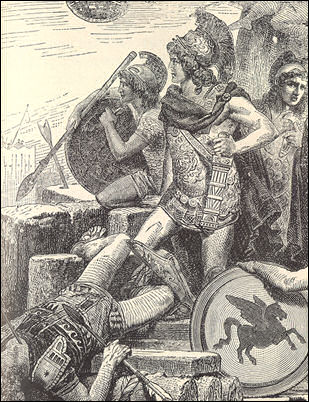
Alexander at the Siege of Tyre Alexander the Great (356 to 324 B.C.) left Macedonia in 334 B.C. at age of 21 with 43,000 foot soldiers and 6,000 horsemen. He would never return home again. After crossing the Hellesport (now known as the Dardanelles), he marched into Asia Minor and then looped around Lebanon, Syria, Israel, Egypt, and Libya before returning to Asia Minor (this took about four years). Then he and his army zigzagged through Iran and Iraq, where important battles were fought (three years), and continued on through the Hindu Kush mountains in Afghanistan and into Pakistan (three years).
Alexander went as far north as present-day Tashkent in Uzbekistan and as far east as Jammu and Armistar in India. He followed the Indus River in present-day Pakistan to the Arabian Sea (two years). The most difficult and costly part of the journey was the trip home via the forbidding Baluchistan desert in southern Pakistan and Iran (one year).
Before setting out on his mission of conquest Alexander arrived unannounced at the Oracle of Delphi. He demanded to see the seeress, and when she refused he dragged her into a temple and forced her to tell his prophecy. Plutarch writes: “As if conquered by his violence, she said, ‘My son, thou art invincible.'”↔
Why died Alexander undertake his mission of conquest and how did Alexander get his men to go along with him on arduous journey of conquest that had little point. Some say the conquest seems to have been a personal matter for Alexander without further meaning. According to historian Jack Keegan, Alexander was comfortably established as ruler of a half-Barbarian Greek city and seemed to have pillaged Persia “largely for the pleasure of it.” Other say Alexander was partly driven by his desire to emulate Achilles and Hercules.
Alexander Battles the Persians at Granicus at Takes Western Asia Minor
Within two years after becoming king Alexander was ready to do battle with Persia, the most powerful kingdom the world had ever known up until that time. The Persian empire extended from present-day Turkey to Pakistan. Alexander’s aim was to avenge the Persian invasion of Greece by Xerxes a century and a half before.
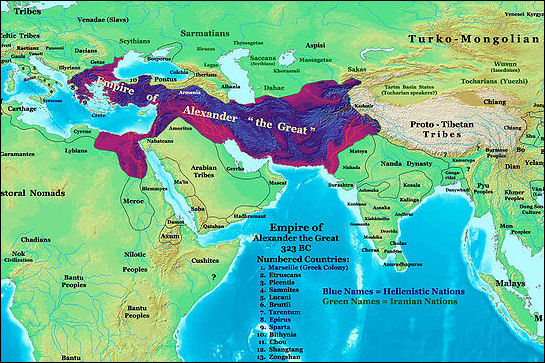
Alexander-Empire 323 BC
After sailing the three-mile distance across the Hellespont Alexander cast his spear into the sand and claimed Asia as his “spear-won prize.” Alexander’s first destination was Troy. There he he paid homage to Achilles and Patrokolos at their tomb and offered sacrifices and anointed altars with oil and traded his armor for Achilles’ sacred shield at the Temple of Athena.
Alexander’s first encounter with the Persians was at Granicus, 100 kilometers northeast of Troy. At that time the Persians controlled the Greek cities along the eastern Aegean. There he faced an advance Persian force of 15,000 cavalry and 16,000 infantry, a third of them Greek mercenaries.
Alexander showed great leadership. The Persian army were spread out over a vast area so Alexander’s forces were able to break through the Persian infantry lines and surrounded the mercenaries of the Persian king.
After the Battle of Granicus, the Persians fled inland. In about a year Alexander conquered most of western Asia Minor and the Aegean Greek cities of Ephesus, Halicarnassus, Magnesia, Perge and Side, where he was greeted as a liberator. At Gordium (near Ankara), the ancient court of King Midas, Alexander “solved” the famous puzzle of the Gordium’s knot by severing it with blow from his sword. According to legend whoever undid the intricately twisted knot would become the ruler of Asia. ↔
As Alexander’s army moved eastward they were just their buying time until they would face off again against the Persians in larger, more pivotal battles.
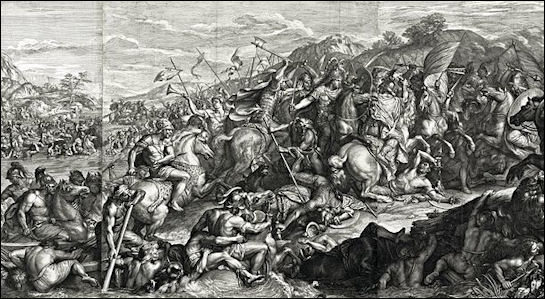
Crossing of the Granicus
Alexander Battles With the Persians at Issus
At Issus (near Adana, Turkey) Alexander’s army of about 50,000 men met a Persian force of perhaps 70,000 men. There is some disagreement over the size the Persian force but most historians agree at least it was larger than Alexander’s.
When Alexander’s army arrived in Issus Alexander ordered them to attack almost immediately even though the soldiers were exhausted from a two-day march. Alexander’s cavalry, backed by archers and infantry wielding 5-½ -meter-long pikes outmaneuvered the larger Persian force with well-orchestrated charges. Alexander and his Companions charged into a barrage of arrows and made straight of the chariot of the Persian leader Darius III. Darius freaked and panicked with the Companions bearing down on him and fled, causing the Persian front to collapse and the enemy to lose the battle. Darius fled so quickly he left behind his family, which were captured and held for ransom (although Alexander gave orders that his wife and daughters would not be harmed).
After the battle, Darius offered Alexander one of his daughters in marriage and 10,000 talents in treasures (about a billion dollars in today’s money) and all of the territory west of the Euphrates, but Alexander refused. After conquering Egypt, Palestine, Syria and Lebanon, Alexander ventured to Mesopotamia where his forces finished off the Persian army, opening the way for his conquest of Asia.↔

Alexander cuts the Gordian Knot
Alexander the Great in the Middle East
As Alexander head down the Mediterranean, nearly all the cities that were under Persian control surrendered and opened their gates to Alexander. The only city that put any resistance was Tyre, a former Phoenician island fortress off the coast of Lebanon.
In the early 6th century, King Nebuchadnezzar laid siege to Tyre for 13 years but was unable to conquer it. In 332 B.C., Alexander the Great captured Tyre by using ship-mounted battering rams and catapults to blast a hole in the fortress wall and gangplanks and two large siege towers to launch the assault.
Alexander’s army had spent seven months building a half mile causeway to the island, with debris from an abandoned mainland city, only to be bombarded with stones and arrows when they got near. The Tyrians also launched a boat with blazing cauldrons to set fire to the attackers. This tactic only delayed the inevitable.
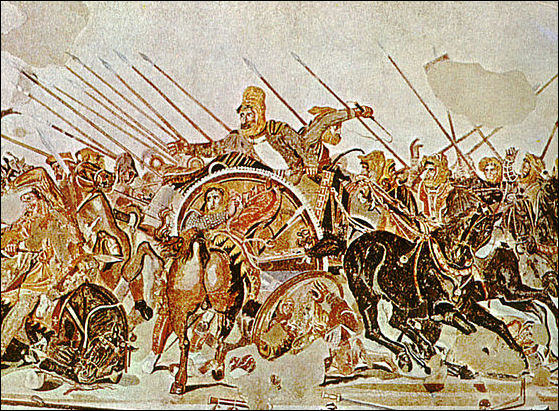
Battle of Issus
The victory over Tyre added Lebanon as well as Palestine, Syria and Egypt to Alexander’s empire.Alexander was reportedly so enraged by the loss of time and men used to capture Tyre that he destroyed half the city, and rounded up its residents, who were either massacred or sold into slavery. Seven thousand people were slaughtered after the capture, 2,000 young men were crucified and 30,000 people were sold into slavery.
Alexander the Great in Egypt
Alexander received a hero’s welcome in Egypt, an unhappy vassal of Persia for nearly 200 years. In Memphis, the Egyptian capital, Alexander was recognized as a pharaoh. Hieroglyphics of Alexander’s adventures adorn temples in Luxor.
In 331 B.C., Alexander the Great trekked 300 miles across the Sahara desert for no military reason to Siwa Oasis (near Libyan border), where he met with the oracle at the Zeus-Amum temple and asked questions about his future and divinity. The oracle greeted Alexander as the son of Amun-Re and gave him the favorable omens he wanted for an invasion of Asia. The 24-year-old Alexander arrived at Siwa by camel. He asked the oracle whether was the son of Zeus. He never revealed the answer to that question.
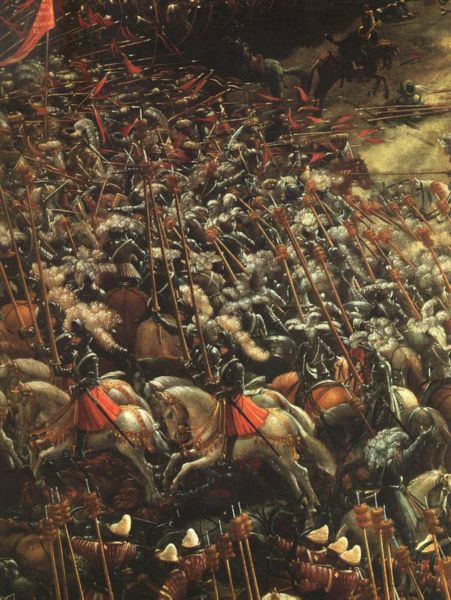
Battle of Issus by Altdorfer
Perhaps the greatest achievement of Alexander’s military campaign was the founding of Alexandria. Arrian wrote that “he himself designed the general layout of the new town, indicating the position of the market square, the number of temples…and the precise limits of its outer defenses.” After Alexander died, Alexandria grew into the center of Hellenistic Greece and was the greatest city for 300 years in Europe and the Mediterranean.
Alexander and the Persians Meet at Guagamela
The key battle in Alexander’s campaign took place at Gaugamela (or Arbela, near Mosel in Iraqi Kurdistan, about 420 kilometers north of present-day Baghdad) in 331 B.C. After Alexander rejected Darius’s offers of peace, Darius had little choice but to prepare for all out war, which he did from the Persian winter capital of Babylon.
Alexander’s force was outnumbered 5 to 1. The Persian army was comprised of 250,000 soldiers from 24 different subject or mercenary armies including ones made up of Indians, Bactrians, Dahae, Medes, Mardians, Babylonians, Parthians and Arachosians. Darius’s force was lead by 40,000 Persian cavalry men clad in chain mail with chariots with scythe blades on their wheels. The Persian leader even had some fighting elephants at his disposal (some say this was the first time Europeans were exposed to elephants). Alexander’s army had 40,000 infantry men and a 7,000-strong cavalry.

Battle of Issus detail
Uncharacteristically, Alexander exercised caution. He waited four days to attack and overslept on the morning of the battle, which was one of the largest and most decisive battles in antiquity. Plutarch wrote, “When his officer came to him in the early morning, they were astonished him not yet awake.”
Fighting at Guagamela
Darius pinned his hopes on his specially-designed chariots which essentially had twirling swords attached to their wheels. To give these vehicles an advantage Darius even went as far as leveling the battlefield and clearing away trees and hills in an area of eight square miles so the chariots could maneuver on the plain where the battle was fought.
Alexander’s forces were arranged in a rectangular box while the Persians were drawn out in a long line. Alexander knew he was outflanked anyway so his plan was to protect his flanks and draw the Persian’s there so he could attack the middle, where Darius was surrounded by bodyguards.

Achaemenid Soldiers
in Persepolis Alexander ordered one wing of his cavalry to charge Darius’s far left flank and another to aim for the far right, leaving his own infantry vulnerable in the center. When the battle began Alexander’s forces moved forward. At the last minute, just as the Persians were set up, Alexander tilted his box, and charged the Persian infantry with a wedge at the right side of the middle. The objective was to draw the Persians to the flanks.
The Persians took the bait. Their cavalry attacked the right flank of Alexander’s rectangular box. When the chariots charged Alexander simply ordered his ranks to part with some soldiers given the task of pulling the drivers to the ground when the chariots passed. The rest were picked off with arrows and javelins.
Alexander the Great Defeats the Persians at Guagamela
The Persians then attacked Alexander’s left flank. As Darius’s mounted forces were pulled into opposite direction Alexander and his elite forces took advantage of the weakness in the middle and made their move there. The Companions formed a wedge and opened up a hole and Alexander himself went right after Darius in the heart of the Persian army, splitting it in two.
The Persian king lost his nerve after his chariot driver was killed by javelin and again he fled, on horseback. Ironically the Persians had regrouped and were ready to mount a bold counter attack but when they heard their had leader had abandoned them once gain they abandoned their assault and the Macedonians were able to defeat an army five times their size with relative ease.↔
Alexander pursued Darius, who was able to get away, but returned to the battlefield to oversee the massacre of the Persian army. When the dust cleared, the Persians lost an estimated 40,000 to 90,000 men while Alexander’s army lost only 100 to 500.
A military historian at West Point, Col, Cole Kingseed, told National Geographic: “Alexander’s tactic were offensive. He anticipated what the enemy would do, forced the enemy to react to him. Alexander went with the arm of decision—that’s one thing we stress, that the commander’s place is where the decisive action is.”
Looting of the Persian Capital and Darius’s Death
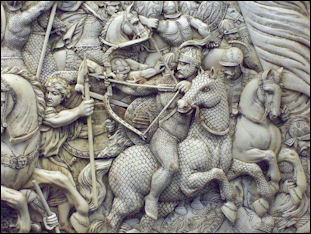
Battle at Gaugamela In less than five years Alexander had defeated the mighty Persians. From Gaugamela Alexander marched his troops victoriously into Babylon, with its gardens and walls, which according to legend were 300 foot high and wide enough to accommodate two chariots riding abreast. Along the way he picked up 15,000 Greek reinforcements.
After a month’s rest Alexander army moved on to Persepolis, the Persian capital, the home of a grand palace with a golden throne and 100-column hall. There Alexander collected almost 3,000 tons in coins, bullion, gold and silver vessels and jewels (worth perhaps billions in today’s dollars). It was one of the richest hordes ever taken. Afterwards Alexander unleashed his soldiers, who formed a drunken mob and burned the palaces of Xerxes to the sound of flutes and songs in revenge against the burning of Athens 150 years before. They also looted art and valuables and killed any male Persians that crossed their path. Great tapestries were placed on the beams of the great palace to set that on fire.
Alexander “accidently” burned down Persepolis in 330 B.C. To carry the treasure of gold, silver and jewels and other goodies back to Greece reportedly required 10,000 mules and 500 camels.
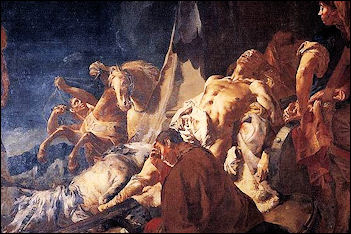
Death of Darius (1746)
by Piazzetta Giovanni The only loose end that needed to be tied was the capture of Darius. Alexander’s army then headed north, moving at an astounding pace of 36 miles a day. At the Caspian gates in the Elburz Mountains (near Tehran) Alexander caught up with Darius. By this time the Persian so feared Alexander that many soldier, according the historian Arrian, “threw themselves over the cliffs.”
Darius himself had been abandoned was found shackled and accompanied by a loyal dog in cart pulled by wounded oxen. He reportedly had been stabbed by his own generals and died after a sympathetic Greek soldier gave him some water. Plutarch wrote: “When Alexander came up, he showed his grief and distress at the king’s death, and unfastened his own cloak, he threw it over the body.”
With the conquest of Persia complete, Alexander now was King Persia as well as Macedonia, and controlled western Asia. Modern Iranians blame Alexander for the decline of the Persian empire. Even today they call him “Alexander the Accursed.”
Alexander the Great in Central Asia
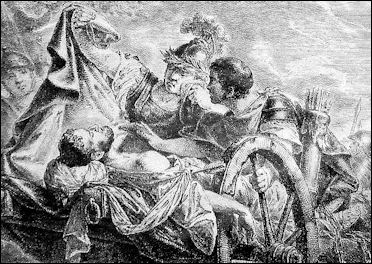
Alexander cloaks body of Darius After Darius’ death rumors spread that the campaign was finished and Alexander was ready to head home. To squash these rumors Alexander called a meeting of his generals and told them, according to a 1st century Roman historian Curtius, “with tears in his eyes, complained he was being brought to a halt in the middle of a brilliant career.”
Alexander then headed into present day Turkmenistan, Afghanistan and Uzbekistan, where he encountered little resistance. By 329 B.C. he had reached present-day Kabul
The nomadic Turkic tribes that live in Central Asia today say that Alexander had two rams horns on the sides of his head and that is why he wore his hair long. Coins minted after his death show Alexander with horns. Later Muslims would call him Iskander Dhulcarnein—Alexander the two horn. In the Turkoman version of the story still told today only Alexander’s barber knew his secret…and he just had to tell someone or something, so he whispered the secret into a well. Reeds began to grow in the well, but whenever someone cut one for a flute, it didn’t make any music it only said “Alexander has two horns.”↔
Alexander’s Conquest’s in Central Asia

Family of Darius before Alexander Alexander’s goal in Central Asia was to capture Bessus, a Persian traitor and ruler of Bactria. After his men suffered from frostbite and severe hunger while crossing a 3,700-meter-high pass in the Hindu Kush in April, when mountains were still covered in snow, Alexander got his hands on Bessus, who was turned over by his allies. Besses was tied a post on the side of a road. After he was taunted and jeered, his ears and nose were cut off. After that he may have been dismembered but more likely he was crucified.
Central Asia was a major crossroad for Silk Road caravans. Hostels and caravansaries were set up every 17 miles, the distance a camel train covers every day. Alexander captured six cities including Samarkand (then called Maracanda) in three days. He set up a headquarters in Samarkand.
Alexander established a number of garrison towns in western Asia and used them to house troops, encourage trade and defend conquered lands. Herat in Afghanistan is the only of these towns that still remains today. It was known in Alexander’s time as Areion.
Alexander Become Paranoid and Kills His Friend
Not everything went smoothly. Alexander’s forces were harassed by nomadic horsemen called the Spitamneses. They made lighting strikes and then retreated before the Greeks could do anything about it. This and road weariness made Alexander’s men increasingly restless and anxious to return home.
By this time Alexander was drinking heavily and had adopted modified Persian dress and customs, something that did not endear him to his loyal Macedon troops. He became increasingly paranoid and displayed wild fits of temper at perceived disloyalty. During one drunken party, when Alexander was boasting about his victories, Cleitus, a friend that once saved his life, said that Alexander owed thanks to his father and the Macedonian veterans that had stood by side all for so many years. Alexander was incensed by this remark. He accused Cleitus of being coward to which Cleitus accused him of pandering to the Persians. Enraged all the more, Alexander grabbed a spear and thrust it through his friend’s chest, killing him instantly. Alexander was instantly filled with remorse and pulled the spear from Cleitus’s body and tried to impale himself. Some officers managed to wrestle the spear from him. Alexander shut himself in his tent for days, grieving.
In Hyrcania on the Caspian Sea, Alexander was given a beautiful eunuch named Bagais, who became Alexander’s lover. This move was not popular either, nor was Alexander’s desire to be treated like a god and requiring his troops to prostrate themselves in front of him and kiss him. Ephippus, a contemporary of Alexander, wrote: “In his honor myrrh and other kinds of incense were consumed in smoke; a religious stillness and silence born of fear held fast all whom were in his presence. For he was intolerable, and murderous, reputed to be melancholy mad.”
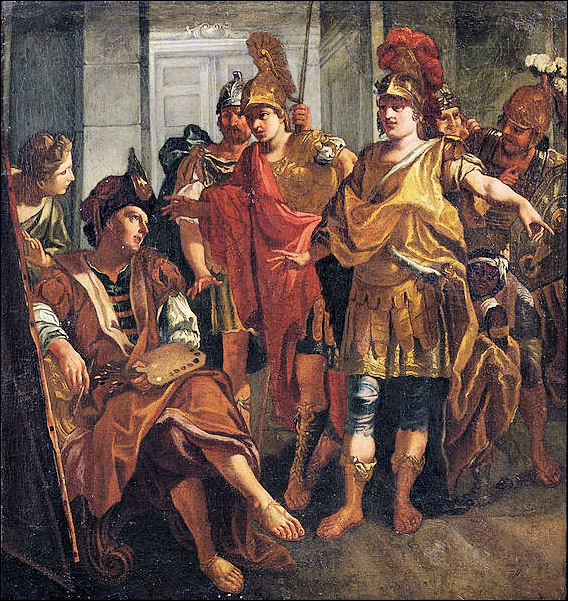
Alexander and Apelles
Alexander the Great in Pakistan
After Central Asia, Alexander then headed into present-day Pakistan because he wanted to add India to his empire. His army of 75,000 men (plus a retinue of perhaps 40,000 more people), now included Persian horseman and many subjects of other conquered kingdoms but only 15,000 Macedonians.
With the Persians gone, Pakistan fell under the under the control of local rulers, none of whom dared to challenge Alexander. His army was able to advance easily and he was given a warm welcome in Taxila. The local ruler there gave him a generous tribute and provided him with fresh soldiers.
In the mountains areas of Central Asia and present-day Pakistan, Alexanders’ armies met fierce resistance from the Dogdians (also known as the Sogdians) and their allies the Masagates (a Saka clan), who retreated to the mountainous areas of the kingdoms and waged guerilla war that halted Alexander’s progress for 18 months.
In the Karakorum range, Alexander’s men used pitons and ropes to assault a supposedly impregnable fortress built into the side of a cliff by the Dogdians at the Rock of Aornos near modern Pir Sar. The soldiers in the fortress had the previous day laughed: “No one can touch us.” When Alexander’s force had taken their positions he said: “Come see my flying soldiers.” The Dogdians in the fortress eventually surrendered and Alexander claimed Roxanne, the daughter of a nobleman, for his wife. Roxanne was reportedly around 12 and Alexander was reportedly quite taken by her beauty. The Rock of Aornos is believed to somewhere in the Hissar mountains but its exact location is unknown.
The Kafir-Kalash, a tribe that lives today in valleys off the Chistral Valley in the North-West Frontier Province of Pakistan, claim to be descendants of five of Alexander the Great’s warriors. The tribe is famous for its their pagan beliefs, lewd songs, provocative dances, partying ways and strange costumes. The women wear black robes, red bead necklaces and cowrie-shell head-dresses.
The Kalash have Caucasian features—sometimes with blonde hair and blue eyes—which gives some credence to their claim they descended from five warriors in Alexander the Great’s army. There are only about 4,000 of them and they have remained pagans despite the fact that everyone around them is Muslim. The Kalash relate a story of Alexander’s bacchanal with mountain dwellers claiming descent from Dionysus. They worship a pantheon of gods, make wine, and practice animal sacrifice. Although Alexander’s armies passed through the Chitral region there is little evidence that they reached the remote valleys where the Kalash live today. Other tribes in Pakistan and Central Asia also claim to be descendants of Alexander’s army.

Alexander and Porus
Alexander the Great Battles Elephants in India
The last great battle of Alexander’s campaign took place at Jhelum on the Indus River (110 kilometers southeast of present-day Islamabad, Pakistan) against King Porus, a massive leader who it is said to have stood nearly seven feet tall and presided over a kingdom that covered much of the Punjab in present-day India and Pakistan.
In the spring of 326 B.C., Alexander’s army engaged King Porus’ force of 35,000 infantrymen, 10,000 cavalry and 200 battle-trained elephants. Curtius wrote, “Porus himself rode an elephant which towered above the other beasts. His armor, with its gold and silver inlay, lent distinction to his unusually large physique.”
The two forces were opposite each other on different sides of the river and Alexander lead his attack in the night during a thunderstorm so the Indian army wouldn’t hear or see him coming. Alexander then concealed part of his cavalry and released the remainder of his army in an attack. Porus committed most army to the Alexander’s charging force and left himself vulnerable to an attack from the concealed cavalry.
In the battle the elephants “kept colliding with friends and foes alike,” according to Arrian. And after several hours the Indians retreated in wild confusion and Porus was captured. Alexander admired Porus’s courage and let him keep his kingdom on the condition he remained loyal to Alexander. Alexander the Great was said to have been rescued from certain death from a charging elephant by a greyhound.
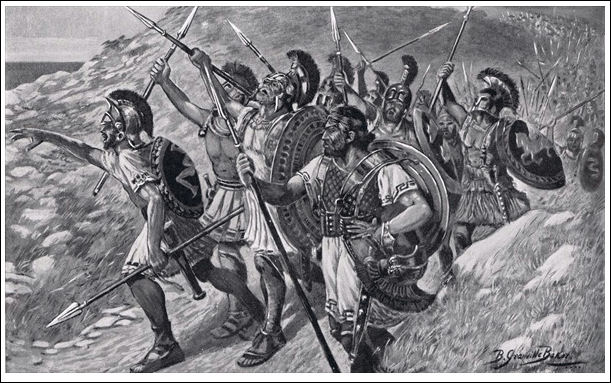
Alexander’s Troops Mutiny
Alexander paused briefly to found a city named Bucephal in honor his horse that died shortly after the battle. The animals died perhaps from old age, perhaps from war wounds. Otherwise Alexander was ready to press on and make further conquests.
But by this time however, the monsoons had set in and Alexander’s men were wet to the bone, tired, homesick and mutinous and perhaps scared of facing off against the Nandas, their next foes, who were referred to in Greeks texts and possessing a formidable army and controlling the Mauryan Empire. Alexander biographer Lane Fox told Smithsonian magazine, “It was pelting with rain, the men were terrified, there snakes everywhere. They were lost and did not feel they could go on anymore.” Historian Peter Green told National Geographic, Alexander was basically screwed by ignorance of geography. He had been telling his men, We’ll just go over the hill, boys—and then suddenly he had the whole of the Ganges plain before him.”
On the banks of the Hyphias (now Beas) River, Alexander ordered his men to head east, the men refused. Alexander was enraged and was little consoled by the words of one of his noble advisors, who told him, “A noble thing, O king, is to know when to stop.” Alexander reacted by saying anyone who disobeyed him would be accused of desertion and went to his tent to sulk. After confining himself to his tent from three days, he consulted his omens and was conveniently told he trouble awaited him in India. On hearing the news his men shouted: “Alexander allowed us, but no others, to defeat him.”Alexander then decided to head back home. In retrospect this may have been a hasty decision as a major Indian army had already been defeated and all of India was within their grasp. ↔
Alexander the Great Arrives at the Arabian Sea

with the Amazons The journey back towards Greece proved to be the most arduous part of the journey—more costly than any battle. Instead of returning home the way they came—over the Hindu Kush. Alexander decided to travel south by river with 1,800 ships through what is now Pakistan to the Arabian Sea, a journey that ended up taking months. First they had to fight their way down the Indus River and resistance was met with slaughter on a genocidal scale. In one attack spearheaded by Alexander himself, the great conqueror took an arrow is his lung and to be carried away in a stretcher, but soon after mounted his horse to show his men he wasn’t finished yet.↔
Alexander’s army of 87,000 infantry, 18,000 cavalry, 52,000 followers arrived at the Arabian Sea, in a part of the world they were unfamiliar with. Because there were to many men to be carried in boats on the Arabian Sea, Alexander’s divided his army, with a small contingent being carried boats and larger contingent journeying overland. A plan was concocted for the army to march overland across the brutal deserts of what is now southern Pakistan and Iran and be supplied by a fleet sailing on Arabian Sea that would meet up with army at various points along the way. That year the monsoon blew the opposite direction and the ships got stuck in Pakistan and were unable to bring supplies to the tens of thousands traveling overland.
Alexander’s Arduous Journey Home

Marriage of Alexander and Roxana Alexander led the largest contingent on a march 1,750 kilometers across the Baluchistan desert, a wasteland more forbidding than the Sahara, and southern Iran. They traveled almost exclusively at night because it was simply too hot during the day. Even at night it travel was difficult as temperatures rarely dropped below 35 degrees C (95 degrees F). Because the supply ships never showed the marchers were forced to subsist on the limited food they brought with them.
The temperatures were blistering and what little water there was largely undrinkable. The trip was so arduous pack animals were butchered and eaten, booty was left behind and more than once the royal stores were broken into. Even then many men died of starvation, thirst and heat.
Alexander suffered along with everyone else. Once he was offered a helmet full of water but he poured it into the sand as a sign that he was willing to share the misery of his troops. Even when there water that could spell trouble too. A large number of his retinue drowned when a flash flood caught them in a canyon.
Alexander’s journey across the deserts of Baluchistan has been compared to Napoleon’s retreat from Moscow. The journey took 60 days. About 15,000 of Alexander’s men, or nearly half the fighting force that accompanied him, perished—more than all the men killed in battle. By contrast, the fleets reached the Iranian coast, delayed but almost intact.
Alexander Returns to Persia

Wedding of Alexander and Roxane In Kirman, Persia Alexander made relations with his men worse when had six of the 20 provincial governors he appointed executed and two more deposed, and then executed 600 men from his own garrisons for raping and pillaging in his absence.
In Susa (Shush, Iran) Alexander took a second wife, Barsine, a daughter of Darius. In a mass wedding—along the lines of those sometimes held by Moonies—10,000 of Alexander’s troops married Persian women and 80 of his officers married daughter of Persian nobles.
Alexander it seemed had become so endeared with Persian culture he had no plans of returning home and instead planned to set up his base of operations in Persia. Some 30,000 noble Persian youths had been taught Greek and methods of Macedonian warfare. As a sort of take off on the Companions they were named the Successors.
By some accounts Alexander’s next destination was Arabia, where he hoped to gain control of area that produced valuable spices. At this time he still “hunted, diced, played ball, joked and banqueted” with his men. In the autumn of 324 B.C., Alexander’s boyhood friend and possible lover Hephaestion became ill with unknown disease and died. Alexander was devastated and had Hephaestion’s doctor crucified.
Image Sources: Wikimedia Commons, The Louvre, The British Museum
Text Sources: New York Times, Washington Post, Los Angeles Times, Times of London, Yomiuri Shimbun, The Guardian, National Geographic, The New Yorker, Time, Newsweek, Reuters, AP, Lonely Planet Guides, Compton’s Encyclopedia and various books and other publications. Most of the information about Greco-Roman science, geography, medicine, time, sculpture and drama was taken from “The Discoverers” [∞] and “The Creators” [μ]” by Daniel Boorstin. Most of the information about Greek everyday life was taken from a book entitled “Greek and Roman Life” by Ian Jenkins from the British Museum [||].
© 2008 Jeffrey Hays







